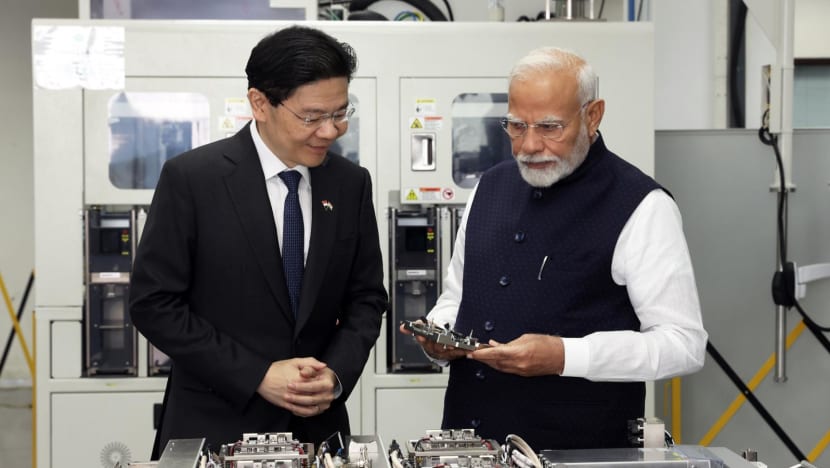Commentary: Crucial for India to seek out strategic partners like Singapore
Countries have fresh impetus to push back against seeing the world in binary choices, says Sinderpal Singh from the S Rajaratnam School of International Studies.

Singapore's Prime Minister Lawrence Wong and India's Prime Minister Narendra Modi at AEM Singapore on Sep 5, 2024. (Photo: Ministry of Digital Development and Information)

This audio is generated by an AI tool.
SINGAPORE: Few countries have had bilateral relationships with the United States and China shift over the past year as dramatically as India.
In August, Indian Prime Minister Narendra Modi made his first visit to China in over seven years, meeting President Xi Jinping at the Shanghai Co-operation Organisation (SCO) Summit. This was a visible sign of improvement in ties, considering tensions between the two countries have been simmering since a military face-off across their shared border culminated in localised skirmishes beginning in 2020.
With the US, however, relations have moved in the opposite direction.
The strong personal relationship between US President Donald Trump and Mr Modi was seen as an advantage for India over other countries in trade negotiations to lower US tariff rates. That relationship seems to have soured.
A hefty 50 per cent tariff rate has taken effect on Indian imports to the US since Aug 27, with India’s purchase of Russian oil given as a key reason. Bilateral relations are probably at the lowest point in at least a decade, accompanied by an upsurge of anti-US sentiment within India.
Against this backdrop, it has become all the more crucial for India to seek out practical and trusted partnerships, to maintain its manoeuvrability in foreign relations and not be forced into making binary choices.
To pursue this goal, relations with countries like Singapore are key for India. The two countries elevated diplomatic ties to a Comprehensive Strategic Partnership when Mr Modi visited Singapore last year, and during Prime Minister Lawrence Wong’s official visit to New Delhi in September this year, the two leaders announced a roadmap for closer cooperation.
There are three key ways in which Singapore’s interests and India’s broader goals fit.
“MULTI-ALIGNMENT” STRATEGY
First, India has long sought not just a multipolar world but a multipolar Asia, where no one power dominates the region. In this regard, China poses the key challenge to India directly across their shared border.
So besides managing direct tensions at the border, China’s growing influence in the rest of South Asia – most visibly in connectivity infrastructure projects but also across the economic, diplomatic and military domains - challenges India’s influence within its own neighbourhood.
India’s response has been to look beyond its subregion and build its “multi-alignment” strategy, engaging with countries in East Asia and the Middle East (India is unique in calling this region West Asia). Though officially part of the Non-Aligned Movement, India has in practice used multi-alignment to fashion a broader coalition of partners and friends and realise its ambitions of becoming a great power.
With the US lacking desire to provide global leadership since Mr Trump’s second term while directly pressing countries to its trade terms, there is fresh impetus for countries to push back against seeing the world in binary choices.
Countries such as India and Singapore appreciate the fundamental role of multilateralism in an increasingly multipolar world and seek to collectively build on multilateral regional institutions and processes. Both India and Singapore seek autonomy in making choices and close bilateral relationships with like-minded partners can help achieve this larger goal.
SEIZING OPPORTUNITY FROM GLOBAL ECONOMIC TUMULT
Second, shifting supply chains driven by global geopolitical concerns have created economic opportunity for India.
The onset of the pandemic and rising US-China tensions led many countries to diversify supply chains for their own national security. But India did not benefit from the earlier “China Plus One” strategy to diversify manufacturing outside of China as much as Southeast Asian countries such as Vietnam, Indonesia and Thailand.
India now finds itself with another opportunity to take advantage of shifting supply chains, given the Trump administration’s focus on using tariffs to get semiconductor chip companies to manufacture chips in the US.
It has undertaken concerted efforts to be a significant player in the semiconductor manufacturing supply chain in recent years.
This will help create job opportunities in the high-technology sector for the approximately 1.5 million graduates every year from Indian engineering colleges. India also has the potential to export Made-in-India chips to non-US markets as countries look to diversify their supply chain dependence not only away from China but also from the US.
However, to seize this opportunity, underlying reforms in India are crucial, specifically those related to the ease of doing business as well as broader liberalisation of the economy.
Singapore, in its position as a hub for semiconductor chip manufacturing, is keen to cooperate with India in this domain. The 2024 MOU between Singapore and India to deepen cooperation in the semiconductor sector was more recently backed up in a road map for closer diplomatic ties, which will further key aims of both countries.
REASSESS TRADE STANCE
Third, while India hopes to negotiate a trade deal with the US to reduce its tariff rate, there is also an appreciation of the opportunity this crisis presents. In a comparable manner to India’s economic reforms in 1991, this external shock could compel Indian leaders to undertake necessary domestic economic reforms, which have slowed down in recent years.
India’s protectionist concerns influenced its withdrawal from the Regional Comprehensive Economic Partnership in 2019. This was viewed by participant countries in East and Southeast Asia, including Singapore, as a setback for regional multilateralism as well as for the trajectory of Indian economic engagement with East Asia which began in the 1990’s.
This trade protectionism – a major grievance of Mr Trump’s – has stifled growth and competitiveness. But a push for great power status needs to be supported by domestic economic growth and deeper regional engagement.
Already there are clear signs India is reassessing its trade stance: It signed a Free Trade Agreement (FTA) with the United Kingdom in July, operationalised its first trade deal with a European grouping in October and is aiming to conclude an FTA with the European Union by the end of 2025.
From Singapore’s perspective, an economically growing and confident India will be an asset to East Asia – providing India with a greater stake in the region and providing the region with the balance of another major power presence.
Dr Sinderpal Singh is Assistant Director and Coordinator of the South Asia Programme and Regional Security Architecture Programme, at the S Rajaratnam School of International Studies, Nanyang Technological University.


















